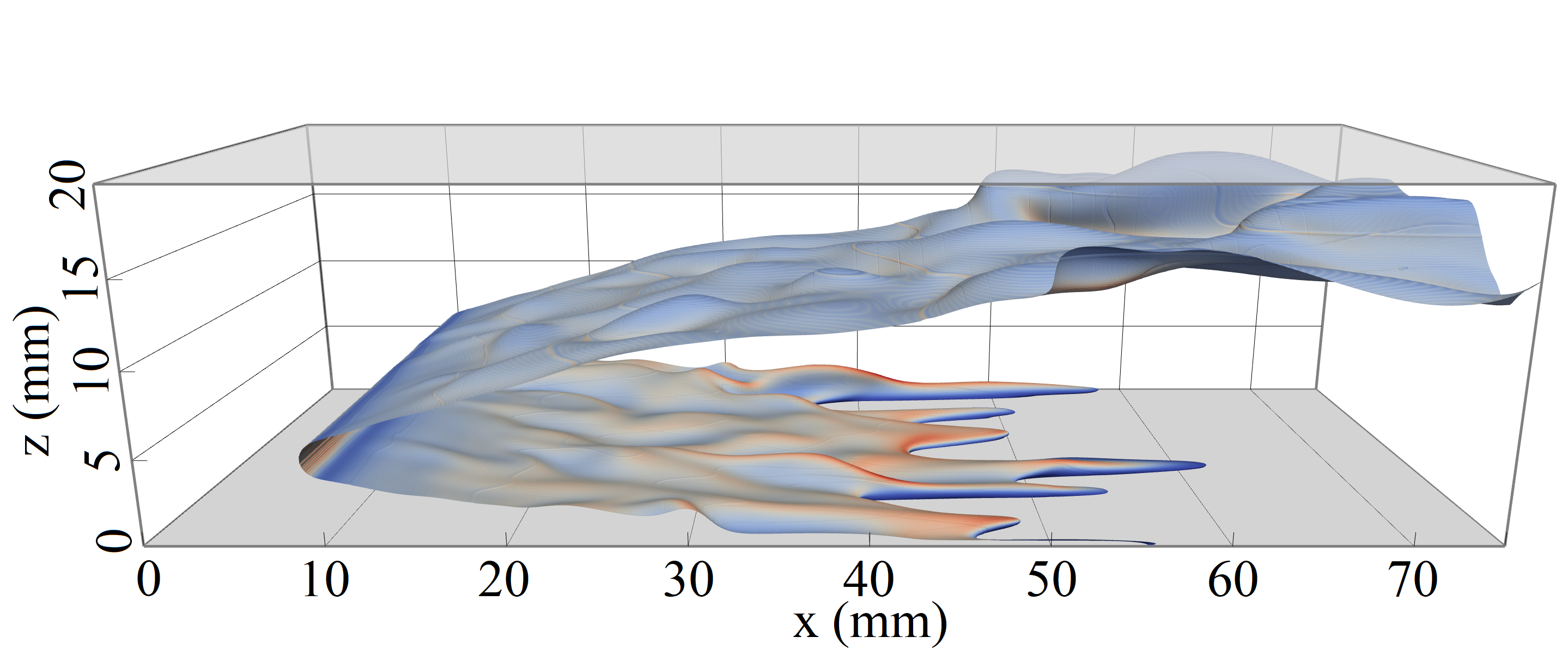Direct numerical simulation of Flame-Wall-Interactions of DME flames
- Principal Investigators:
- Prof. Dr.-Ing. Christian Hasse
- Project Manager:
- Driss Kaddar
- additional Affiliation:
- EU Horizon 2020: Center of Excellence in Combustion, DFB Sonderforschungsbereich TRR 150
- HPC Platform used:
- NHR4CES@TUDa: Lichtenberg Cluster Darmstadt
- Project ID:
- 01594
- Date published:
- Researchers:
- Matthias Steinhausen, Federica Ferraro, Thorsten Zirwes
- Introduction:
- The energy transition is a global challenge with major economic and social impact. Future combustion devices will have to adapt to enable low-carbon or carbon-free sustainable power generation. The design of high efficiency devices and the use of alternative fuels is heavily supported by computational fluid dynamics simulation. However, detailed simulations of complete combustion systems are still computationally unfeasible to this day. This illustrates the need for accurate but less computationally demanding models. In this project, a direct numerical simulation (DNS) of turbulent flame wall interaction was conducted to provide further physical insight to near wall combustion processes and to contribute to the development of novel combustion models.
- Body:
-
The energy transition is a global challenge with major economic and social impact. While in the foreseeable future, combustion will still meet a major part of the world’s primary energy demand, technologies will have to change to achieve low-carbon and carbon-free sustainable combustion, using high efficiency devices and synthetic fuels as key contributors. A current tendency in technology is towards smaller combustion devices, e.g., in internal combustion engines and gas turbines, that enable higher pressure ratios and therefore, reach higher efficiencies. However, this evolution increases the surface to volume ratio that leads to a growing influence of near wall phenomena on the overall combustion process.
The interaction of the flame with the surrounding walls has a crucial influence on the overall efficiency. Due to heat-losses at the cold walls, the chemical reactions within the flame may stagnate. This leads to incomplete combustion in close vicinity to the walls, which has a major impact on pollutant formation. Additionally, for the transformation to a CO2-neutral energy system, finding replacements for fossil fuels is essential. These alternative fuels are produced from biomass or by using H2 from renewable electricity and CO2 from the atmosphere, and thereby allow for a CO2-neutral combustion process. Dimethyl ether (DME) is a promising low-emission and environmentally friendly alternative to diesel. To optimize the geometries and operating conditions in modern, low emission internal combustion engines, the understanding of the underlying processes of the chemical reacting near wall flow is essential. Furthermore, for more complex flame configurations, like flame-wall interactions, DME can serve as a starting point for systematic studies of more complex oxygenated fuels.
In this project, a Direct Numerical Simulation (DNS) of the turbulent flame wall interaction of a DME flame was conducted. Simulations were carried out using the robust cell-centred finite-volume method framework of the open-source toolbox OpenFOAM. In OpenFOAM, parallelization is employed by utilizing Pstream and MPI for inter-processor communication. Therefore, the computational domain is decomposed into a multitude of subdomains, which are distributed amongst the processors. For the DNS, a custom numerical solver with detailed chemistry and mixture averaged transport developed at Engler-Bunte-Institute of KIT was used [1]. This solver makes use of additional coupling to the Cantera and Sundials libraries to efficiently solve the computationally demanding parts of detailed chemistry. The calculations for this research were conducted on the Lichtenberg high-performance computer of the TU Darmstadt. Up to 10500 CPU cores and a total of 7 million CPU hours were used.
Results from the DNS provided detailed insight into the underlying physics of near wall combustion and pollutant formation. It was shown, that turbulence and heat losses towards the wall resulted in combined effects on the flame dynamics. Additionally, the results serve as a benchmark database for the development and validation of novel strategies for reduced order models in Large Eddy Simulations (LES) of near wall combustion. One approach that is currently being pursued is model development based on machine learning. There, the aim is to retrieve all relevant species information by inference of artificial neural networks trained on simpler one- or two-dimensional configurations. Such a model could also be generalized to be applicable for other alternative fuels (e.g., H2 or H2/natural gas blends). Thus, results from this simulation contribute in making LES of combustion processes of alternative fuels feasible in complex geometries.
References
[1]: Zirwes, T., Zhang, F., Habisreuther, P., Hansinger, M., Bockhorn, H., Pfitzner, M.,
Trimis, D. (2020) Quasi-DNS Dataset of a Piloted Flame with Inhomogeneous Inlet
Conditions; Flow, Turbulence and Combustion. vol. 104, pp. 997–1027.
- Institute / Institutes:
- Simulation reaktiver Thermo-Fluid Systeme (STFS)
- Affiliation:
- Technische Universität Darmstadt
- Image:
-
